常用酿酒酵母菌株基因型
- 格式:docx
- 大小:27.69 KB
- 文档页数:7
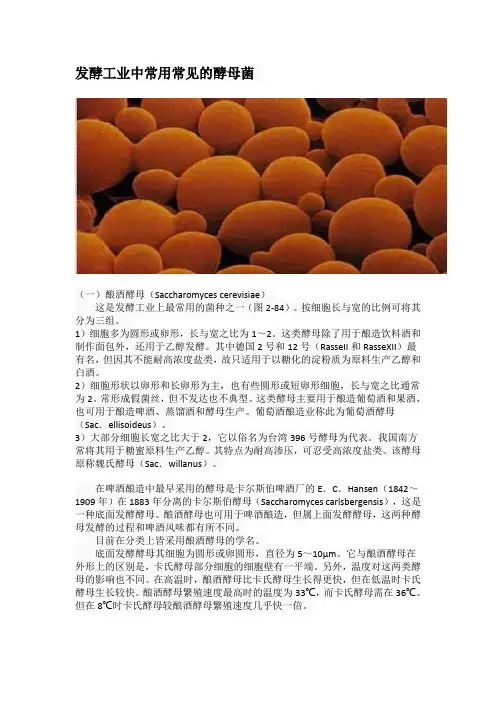
发酵工业中常用常见的酵母菌(一)酿酒酵母(Saccharomyces cerevisiae)这是发酵工业上最常用的菌种之一(图2-84)。
按细胞长与宽的比例可将其分为三组。
1)细胞多为圆形或卵形,长与宽之比为1~2。
这类酵母除了用于酿造饮料酒和制作面包外,还用于乙醇发酵。
其中德国2号和12号(RasseII和RasseXII)最有名,但因其不能耐高浓度盐类,故只适用于以糖化的淀粉质为原料生产乙醇和白酒。
2)细胞形状以卵形和长卵形为主,也有些圆形或短卵形细胞,长与宽之比通常为2。
常形成假菌丝,但不发达也不典型。
这类酵母主要用于酿造葡萄酒和果酒,也可用于酿造啤酒、蒸馏酒和酵母生产。
葡萄酒酿造业称此为葡萄酒酵母(Sac.ellisoideus)。
3)大部分细胞长宽之比大于2,它以俗名为台湾396号酵母为代表。
我国南方常将其用于糖蜜原料生产乙醇。
其特点为耐高渗压,可忍受高浓度盐类。
该酵母原称魏氏酵母(Sac.willanus)。
在啤酒酿造中最早采用的酵母是卡尔斯伯啤酒厂的E.C.Hansen(1842~1909年)在1883年分离的卡尔斯伯酵母(Saccharomyces carlsbergensis),这是一种底面发酵酵母。
酿酒酵母也可用于啤酒酿造,但属上面发酵酵母,这两种酵母发酵的过程和啤酒风味都有所不同。
目前在分类上皆采用酿酒酵母的学名。
底面发酵酵母其细胞为圆形或卵圆形,直径为5~10μm。
它与酿酒酵母在外形上的区别是,卡氏酵母部分细胞的细胞壁有一平端。
另外,温度对这两类酵母的影响也不同。
在高温时,酿酒酵母比卡氏酵母生长得更快,但在低温时卡氏酵母生长较快。
酿酒酵母繁殖速度最高时的温度为33℃,而卡氏酵母需在36℃。
但在8℃时卡氏酵母较酿酒酵母繁殖速度几乎快一倍。
(二)异常汉逊酵母(Hansenula anomala)细胞为圆形,直径4~7μm,椭圆形成腊肠形,大小为(2.5~6)μm×(4.5~20)μm,甚至有长达30μm的长细胞,多边芽殖,发酵,液面有白色菌醭,培养液混浊,有菌体沉淀于管底(图2-85)。
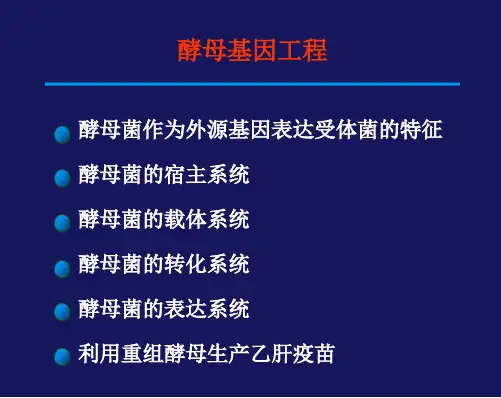
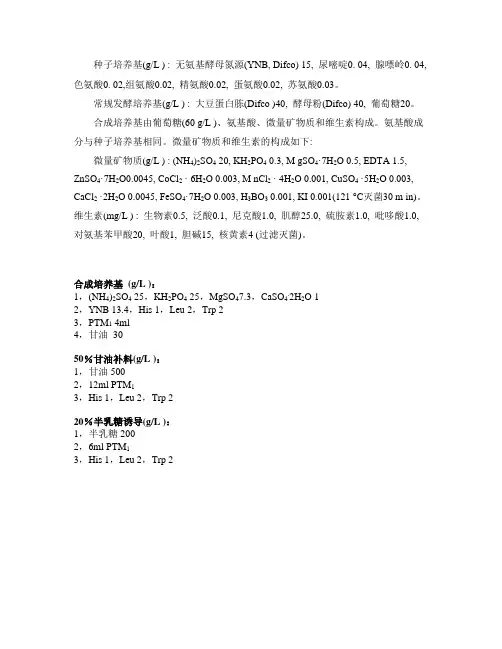
种子培养基(g/L ) : 无氨基酵母氮源(YNB, Difco) 15, 尿嘧啶0. 04, 腺嘌岭0. 04, 色氨酸0. 02,组氨酸0.02, 精氨酸0.02, 蛋氨酸0.02, 苏氨酸0.03。
常规发酵培养基(g/L ) : 大豆蛋白胨(Difco )40, 酵母粉(Difco) 40, 葡萄糖20。
合成培养基由葡萄糖(60 g/L )、氨基酸、微量矿物质和维生素构成。
氨基酸成分与种子培养基相同。
微量矿物质和维生素的构成如下:微量矿物质(g/L ) : (NH4)2SO4 20, KH2PO4 0.3, M gSO4·7H2O 0.5, EDTA 1.5, ZnSO4·7H2O0.0045, CoCl2 · 6H2O 0.003, M nCl2 · 4H2O 0.001, CuSO4 ·5H2O 0.003, CaCl2 ·2H2O 0.0045, FeSO4·7H2O 0.003, H3BO3 0.001, KI 0.001(121 °C灭菌30 m in)。
维生素(mg/L ) : 生物素0.5, 泛酸0.1, 尼克酸1.0, 肌醇25.0, 硫胺素1.0, 吡哆酸1.0, 对氨基苯甲酸20, 叶酸1, 胆碱15, 核黄素4 (过滤灭菌)。
合成培养基(g/L ):1,(NH4)2SO4 25,KH2PO4 25,MgSO47.3,CaSO4.2H2O 12,YNB 13.4,His 1,Leu 2,Trp 23,PTM1 4ml4,甘油3050%甘油补料(g/L ):1,甘油5002,12ml PTM13,His 1,Leu 2,Trp 220%半乳糖诱导(g/L ):1,半乳糖2002,6ml PTM13,His 1,Leu 2,Trp 2。
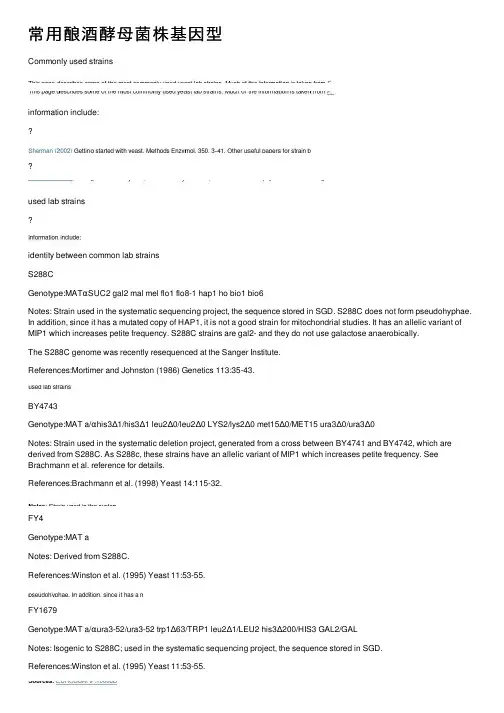
常⽤酿酒酵母菌株基因型Commonly used strainsinformation include:used lab strainsidentity between common lab strainsS288CGenotype:MATαSUC2 gal2 mal mel flo1 flo8-1 hap1 ho bio1 bio6Notes: Strain used in the systematic sequencing project, the sequence stored in SGD. S288C does not form pseudohyphae. In addition, since it has a mutated copy of HAP1, it is not a good strain for mitochondrial studies. It has an allelic variant of MIP1 which increases petite frequency. S288C strains are gal2- and they do not use galactose anaerobically.The S288C genome was recently resequenced at the Sanger Institute.References:Mortimer and Johnston (1986) Genetics 113:35-43.BY4743Genotype:MAT a/αhis3Δ1/his3Δ1 leu2Δ0/leu2Δ0 LYS2/lys2Δ0 met15Δ0/MET15 ura3Δ0/ura3Δ0Notes: Strain used in the systematic deletion project, generated from a cross between BY4741 and BY4742, which are derived from S288C. As S288c, these strains have an allelic variant of MIP1 which increases petite frequency. See Brachmann et al. reference for details.References:Brachmann et al. (1998) Yeast 14:115-32.FY4Genotype:MAT aNotes: Derived from S288C.References:Winston et al. (1995) Yeast 11:53-55.FY1679Genotype:MAT a/αura3-52/ura3-52 trp1Δ63/TRP1 leu2Δ1/LEU2 his3Δ200/HIS3 GAL2/GALNotes: Isogenic to S288C; used in the systematic sequencing project, the sequence stored in SGD.References:Winston et al. (1995) Yeast 11:53-55.AB972Genotype:MATα X2180-1B trp10 [rho 0]Notes: Isogenic to S288C; used in the systematic sequencing project, the sequence stored in SGD. AB972 is an ethidium bromide-induced rho- derivative of the strain X2180-1B-trp1.References:Olson MV et al. (1986) Proc. Natl. Acad. Sci. USA 83:7826-7830.A364AGenotype:MAT a ade1 ade2 ura1 his7 lys2 tyr1 gal1 SUC mal cup BIONotes: Used in the systematic sequencing project, the sequence stored in SGD.References:Hartwell (1967) J. Bacteriol. 93:1662-1670.XJ24-24aGenotype:MAT a ho HMa HMα ade6 arg4-17 trp1-1 tyr7-1 MAL2Notes: Derived from, but not isogenic to, S288CReferences:Strathern et al. (1979) Cell 18:309-319DC5Genotype:MAT a leu2-3,112 his3-11,15 can1-11Notes: Isogenic to S288C; used in the systematic sequencing project, the sequence stored in SGD.References:Broach et al. (1979) Gene 8:121-133X2180-1AGenotype:MAT a SUC2 mal mel gal2 CUP1Notes:S288c spontaneously diploidized to give rise to X2180. The haploid segregants X2180-1a and X2180-1b were obtained from sporulated X2180YNN216Genotype:MAT a/αura3-52/ura3-52 lys2-801amber/lys2-801amber ade2-101ochre/ade2-101ochreNotes: Congenic to S288C (see Sikorski and Hieter). Used to derive YSS and CY strains (see Sobel and Wolin). References:Sikorski RS and Hieter P (1989) Genetics 122:19-27.YPH499Genotype:MAT a ura3-52 lys2-801_amber ade2-101_ochre trp1-Δ63 his3-Δ200 leu2-Δ1Notes: Contains nonrevertible (deletion) auxotrophic mutations that can be used for selection of vectors. Notethat trp1-Δ63, unlike trp1-Δ1, does not delete adjacent GAL3 UAS sequence and retains homology to TRP1 selectable marker.gal2-, does not use galactose anaerobically. Derived from the diploid strain YNN216 (Johnston and Davis 1984; original source: M. Carlson, Columbia University), which is congenic with S288C.References:Sikorski RS and Hieter P (1989) Genetics 122:19-27.YPH500Genotype:MATαura3-52 lys2-801_amber ade2-101_ochre trp1-Δ63 his3-Δ200 leu2-Δ1Notes:MATα strain isogenic to YPH499 except at mating type locus. Derived from the diploid strain YNN216 (Johnston and Davis 1984; original source: M. Carlson, Columbia University), which is congenic with S288C. References:Sikorski RS and Hieter P (1989) Genetics 122:19-27.YPH501Genotype:MAT a/MATαura3-52/ura3-52 lys2-801_amber/lys2-801_amber ade2-101_ochre/ade2-101_ochretrp1-Δ63/trp1-Δ63 his3-Δ200/his3-Δ200 leu2-Δ1/leu2-Δ1Notes:a/α diploid isogenic to YPH499 and YPH500. Derived from the diploid strain YNN216 (Johnston and Davis 1984; original source: M. Carlson, Columbia University), which is congenic with S288C.References:Sikorski RS and Hieter P (1989) Genetics 122:19-27.Sigma 1278BNotes: Used in pseudohyphal growth studies. Detailed notes about the sigma strains have been kindly provided by Cora Styles.Sigma1278B background contain a nonsense mutation in RIM15, a G-to-T transversion at position 1216 that converts a Gly codon to an opal stop codon. This rim15 mutation interacts epistatically with mutations in certain other genes to affect colony morphology.Annotation of the Sigma1278b genome and information about the systematic deletion collection can be found here. SK1 Genotype:MAT a/α HO gal2 cup S can1R BIONotes: Commonly used for studying sporulation or meiosis. Canavanine-resistant derivative.The SK1 genome was sequenced at the Sanger Institute.References:Kane SM and Roth J. (1974) Bacteriol. 118: 8-14CEN.PK (aka CEN.PK2)Genotype:MAT a/α ura3-52/ura3-52 trp1-289/trp1-289 leu2-3_112/leu2-3_112 his3 Δ1/his3 Δ1 MAL2-8C/MAL2-8CSUC2/SUC2Notes: CEN.PK possesses a mutation in CYR1 (A5627T corresponding to a K1876M substitution near the end of the catalytic domain in adenylate cyclase which eliminates glucose- and acidification-induced cAMP signalling and delaysReferences:van Dijken et al. (2000) Enzyme Microb Technol 26:706-714W303Genotype:MAT a/MATα {leu2-3,112 trp1-1 can1-100 ura3-1 ade2-1 his3-11,15} [phi+]Notes: W303 also contains a bud4 mutation that causes haploids to bud with a mixture of axial and bipolar budding patterns. In addition, the original W303 strain contains the rad5-535 allele. As S288c, W303 has an allelic variantof MIP1 which increases petite frequency.The W303 genome was sequenced at the Sanger Institute.References: W303 constructed by Rodney Rothstein (see detailed notes from RR and Stephan Bartsch).bud4 info: Voth et al. (2005) Eukaryotic Cell, 4:1018-28.rad5-535 info: Fan et al. (1996) Genetics 142:749W303-1AGenotype:MAT a {leu2-3,112 trp1-1 can1-100 ura3-1 ade2-1 his3-11,15}Notes: W303-1A possesses a ybp1-1 mutation (I7L, F328V, K343E, N571D) which abolishes Ybp1p function, increasing sensitivity to oxidative stress.References: W303 constructed by Rodney Rothstein (see detailed notes from RR and Stephan Bartsch).ybp1-1 info: Veal et al. (2003) J. Biol. Chem. 278:30896-904.W303-1BGenotype:MATα {leu2-3,112 trp1-1 can1-100 ura3-1 ade2-1 his3-11,15}References: W303 constructed by Rodney Rothstein (see detailed notes from RR and Stephan Bartsch).W303-K6001Genotype:MAT a; {ade2-1, trp1-1, can1-100, leu2-3,112, his3-11,15, GAL, psi+, ho::HO::CDC6 (at HO), cdc6::hisG,ura3::URA3 GAL-ubiR-CDC6 (at URA3)}References: K6001 was developed by Bobola et al in Kim Nasmyth's lab (PMID: 8625408), and has become a common model in yeast aging research (PMID: 15489200). Its genome has been sequenced by Timmermann et al (PMID: 20729566) D273-10BGenotype:MATαmalNotes: Normal cytochrome content and respiration; low frequency of rho-. This strain and its auxotrophic derivatives were used in numerious laboratories for mitochondrial and related studies and for mutant screens. Good respirer that's relatively resistant to glucose repression.References:Sherman, F. (1963) Genetics 48:375-385.FL100Genotype:MAT aReferences:Lacroute, F. (1968) J. Bacteriol. 95:824-832.Sources: ATCC: 28383SEY6210/SEY6211Genotype:MAT a/MATαleu2-3,112/leu2-3,112 ura3-52/ura3-52 his3-Δ200/his3-Δ200 trp1-Δ901/trp1-Δ901ade2/ADE2 suc2-Δ9/suc2-Δ9 GAL/GAL LYS2/lys2-801Notes: SEY6210/SEY6211, also known as SEY6210.5, was constructed by Scott Emr and has been used in studies of autophagy, protein sorting etc. It is the product of crossing with strains from 5 different labs (Gerry Fink, Ron Davis, David Botstein, Fred Sherman, Randy Schekman). It has several selectable markers, good growth properties and good sporulation.References:Robinson et al. (1988) Mol Cell Biol 8(11):4936-48SEY6210Genotype:MATαleu2-3,112 ura3-52 his3-Δ200 trp1-Δ901 suc2-Δ9 lys2-801; GALNotes: SEY6210 is a MATalpha haploid constructed by Scott Emr and has been used in studies of autophagy, protein sorting etc. It is the product of crossing with strains from 5 different labs (Gerry Fink, Ron Davis, David Botstein, Fred Sherman, Randy Schekman). It has several selectable markers and good growth properties.References:Robinson et al. (1988) Mol Cell Biol 8(11):4936-48SEY6211Genotype:MAT a leu2-3,112 ura3-52 his3-Δ200 trp1-Δ901 ade2-101 suc2-Δ9; GALNotes: SEY6211 is a MATa haploid constructed by Scott Emr and has been used in studies of autophagy, protein sorting etc. It is the product of crossing with strains from 5 different labs (Gerry Fink, Ron Davis, David Botstein, Fred Sherman, Randy Schekman). It has several selectable markers and good growth properties.References:Robinson et al. (1988) Mol Cell Biol 8(11):4936-48JK9-3dThere are a, alpha and a/alpha diploids of JK9-3d with the following genotypes:Genotypes: JK9-3da MAT a leu2-3,112 ura3-52 rme1 trp1 his4JK9-3dα has the same genotype as JK9-3da with the exception of the MAT locusJK9-3da/α is homozygous for all markers except mating typeNotes: JK9-3d was constructed by Jeanette Kunz while in Mike Hall's lab. She made the original strain while Joe Heitman isolated isogenic strains of opposite mating type and derived the a/alpha isogenic diploid by mating type switching. It has in its background S288c, a strain from the Oshima lab, and a strain from the Herskowitz lab. It was chosen because of its robust growth and sporulation, as well as good growth on galactose (GAL+) (so that genes under control of the galactose promoter could be induced). It may also have a SUP mutation that allows translation through premature STOP codons and therefore produces functional alleles with many point mutations.88(5):1948-52RM11-1aGenotype:MAT a leu2Δ ura3Δ ho::KanNotes: RM11-1a is a haploid derivative of Bb32(3), a natural isolate collected by Robert Mortimer from a California vineyard, as in Mortimer et al., 1994. It has high spore viability (80–90%) and has been extensively characterized phenotypically under a wide range of conditions. It has a significantly longer life span than typical lab yeast strains and accumulates age-associated abnormalities at a lower rate. It displays approximately 0.5–1% sequence divergence relative to S288c. More information is available at the Broad Institute website.References:Brem et al. (2002) Science 296(5568):752-5Y55Genotype:MAT a /MAT alpha HO/HONotes: Y55 is a prototrophic, homothallic diploid strain that was originally isolated by Dennis Winge. Many auxotrophic mutant derivatives have been created by John McCusker by using ethidium bromide treatment to eliminate。
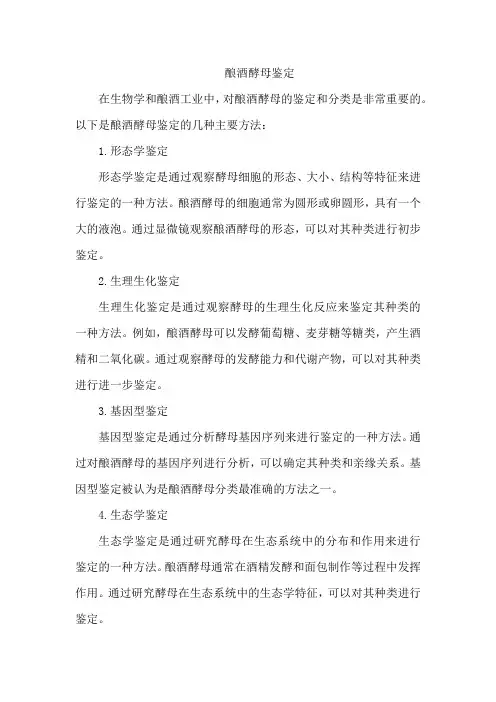
酿酒酵母鉴定在生物学和酿酒工业中,对酿酒酵母的鉴定和分类是非常重要的。
以下是酿酒酵母鉴定的几种主要方法:1.形态学鉴定形态学鉴定是通过观察酵母细胞的形态、大小、结构等特征来进行鉴定的一种方法。
酿酒酵母的细胞通常为圆形或卵圆形,具有一个大的液泡。
通过显微镜观察酿酒酵母的形态,可以对其种类进行初步鉴定。
2.生理生化鉴定生理生化鉴定是通过观察酵母的生理生化反应来鉴定其种类的一种方法。
例如,酿酒酵母可以发酵葡萄糖、麦芽糖等糖类,产生酒精和二氧化碳。
通过观察酵母的发酵能力和代谢产物,可以对其种类进行进一步鉴定。
3.基因型鉴定基因型鉴定是通过分析酵母基因序列来进行鉴定的一种方法。
通过对酿酒酵母的基因序列进行分析,可以确定其种类和亲缘关系。
基因型鉴定被认为是酿酒酵母分类最准确的方法之一。
4.生态学鉴定生态学鉴定是通过研究酵母在生态系统中的分布和作用来进行鉴定的一种方法。
酿酒酵母通常在酒精发酵和面包制作等过程中发挥作用。
通过研究酵母在生态系统中的生态学特征,可以对其种类进行鉴定。
5.抗性鉴定抗性鉴定是通过观察酵母对抗菌剂的抵抗力来进行鉴定的一种方法。
不同种类的酵母对抗菌剂的抵抗力不同。
通过抗性鉴定可以初步确定酵母的种类。
6.代谢产物鉴定代谢产物鉴定是通过分析酵母代谢产物的种类和含量来进行鉴定的一种方法。
不同种类的酵母具有不同的代谢途径和产物。
通过分析代谢产物的种类和含量,可以对其种类进行鉴定。
7.生长曲线鉴定生长曲线鉴定是通过观察酵母在不同环境下的生长曲线来进行鉴定的一种方法。
不同种类的酵母在不同环境下具有不同的生长曲线。
通过生长曲线鉴定可以初步确定酵母的种类和适应环境的能力。
以上就是酿酒酵母鉴定的几种主要方法,每种方法都有其独特的优点和局限性,需要根据具体的应用场景选择合适的方法进行鉴定。
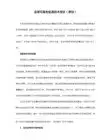
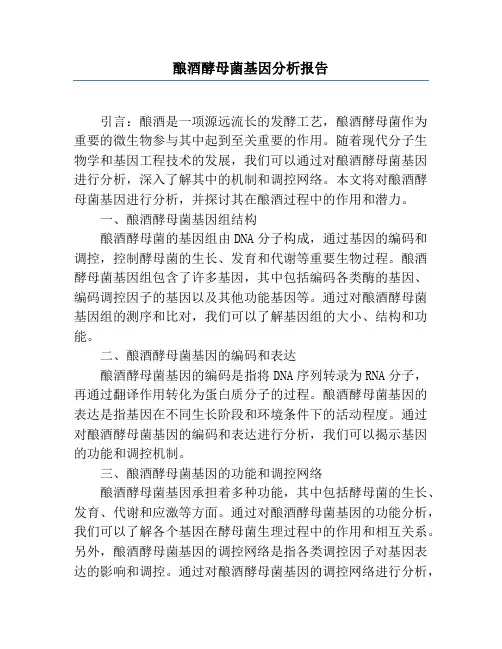
酿酒酵母菌基因分析报告引言:酿酒是一项源远流长的发酵工艺,酿酒酵母菌作为重要的微生物参与其中起到至关重要的作用。
随着现代分子生物学和基因工程技术的发展,我们可以通过对酿酒酵母菌基因进行分析,深入了解其中的机制和调控网络。
本文将对酿酒酵母菌基因进行分析,并探讨其在酿酒过程中的作用和潜力。
一、酿酒酵母菌基因组结构酿酒酵母菌的基因组由DNA分子构成,通过基因的编码和调控,控制酵母菌的生长、发育和代谢等重要生物过程。
酿酒酵母菌基因组包含了许多基因,其中包括编码各类酶的基因、编码调控因子的基因以及其他功能基因等。
通过对酿酒酵母菌基因组的测序和比对,我们可以了解基因组的大小、结构和功能。
二、酿酒酵母菌基因的编码和表达酿酒酵母菌基因的编码是指将DNA序列转录为RNA分子,再通过翻译作用转化为蛋白质分子的过程。
酿酒酵母菌基因的表达是指基因在不同生长阶段和环境条件下的活动程度。
通过对酿酒酵母菌基因的编码和表达进行分析,我们可以揭示基因的功能和调控机制。
三、酿酒酵母菌基因的功能和调控网络酿酒酵母菌基因承担着多种功能,其中包括酵母菌的生长、发育、代谢和应激等方面。
通过对酿酒酵母菌基因的功能分析,我们可以了解各个基因在酵母菌生理过程中的作用和相互关系。
另外,酿酒酵母菌基因的调控网络是指各类调控因子对基因表达的影响和调控。
通过对酿酒酵母菌基因的调控网络进行分析,我们可以揭示调控因子之间的相互关系和调控机制。
四、未来展望和应用价值酿酒酵母菌基因分析为我们深入了解酵母菌生理过程提供了重要的工具和方法。
未来我们可以通过基因工程技术对酿酒酵母菌基因进行改造,以生产出更符合市场需求的酿酒产品。
同时,对酿酒酵母菌基因的深入研究还可以帮助我们理解其他微生物的生理过程,为微生物工程和发酵工业的发展提供理论基础和技术支持。
结论:通过对酿酒酵母菌基因的分析,我们可以深入了解酿酒过程中的生理过程和调控网络。
基因分析为我们解决实际问题和推动酿酒工业的发展提供了新的思路和方法。
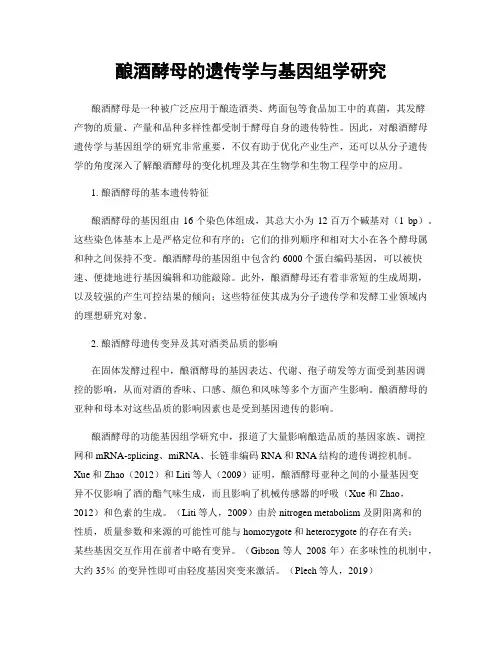
酿酒酵母的遗传学与基因组学研究酿酒酵母是一种被广泛应用于酿造酒类、烤面包等食品加工中的真菌,其发酵产物的质量、产量和品种多样性都受制于酵母自身的遗传特性。
因此,对酿酒酵母遗传学与基因组学的研究非常重要,不仅有助于优化产业生产,还可以从分子遗传学的角度深入了解酿酒酵母的变化机理及其在生物学和生物工程学中的应用。
1. 酿酒酵母的基本遗传特征酿酒酵母的基因组由16个染色体组成,其总大小为12百万个碱基对(1 bp)。
这些染色体基本上是严格定位和有序的;它们的排列顺序和相对大小在各个酵母属和种之间保持不变。
酿酒酵母的基因组中包含约6000个蛋白编码基因,可以被快速、便捷地进行基因编辑和功能敲除。
此外,酿酒酵母还有着非常短的生成周期,以及较强的产生可控结果的倾向;这些特征使其成为分子遗传学和发酵工业领域内的理想研究对象。
2. 酿酒酵母遗传变异及其对酒类品质的影响在固体发酵过程中,酿酒酵母的基因表达、代谢、孢子萌发等方面受到基因调控的影响,从而对酒的香味、口感、颜色和风味等多个方面产生影响。
酿酒酵母的亚种和母本对这些品质的影响因素也是受到基因遗传的影响。
酿酒酵母的功能基因组学研究中,报道了大量影响酿造品质的基因家族、调控网和mRNA-splicing、miRNA、长链非编码RNA和RNA结构的遗传调控机制。
Xue和Zhao(2012)和Liti等人(2009)证明,酿酒酵母亚种之间的小量基因变异不仅影响了酒的酯气味生成,而且影响了机械传感器的呼吸(Xue和Zhao,2012)和色素的生成。
(Liti等人,2009)由於 nitrogen metabolism 及阴阳离和的性质,质量参数和来源的可能性可能与homozygote和heterozygote的存在有关;某些基因交互作用在前者中略有变异。
(Gibson等人2008年)在多味性的机制中,大约 35%的变异性即可由轻度基因突变来激活。
(Plech等人,2019)3. 酿酒酵母的基因组学研究进展2009年,国际酿酒酵母功能基因组合作组织(SGRP)发布了酿酒酵母的全基因组序列,并发表了其最早的基因组学研究结果。
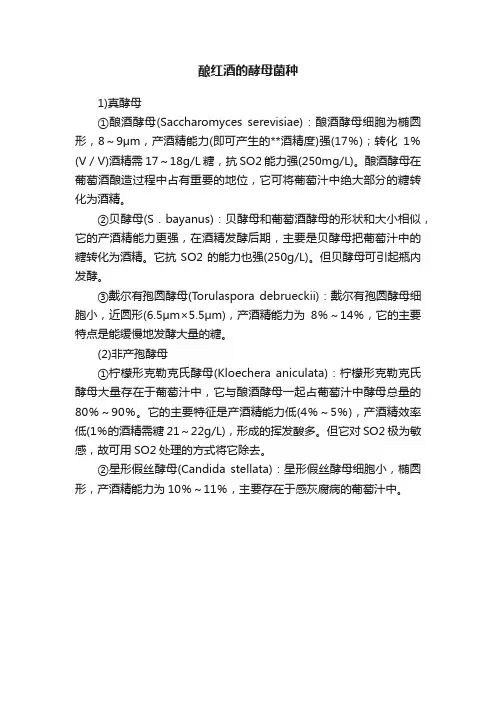
酿红酒的酵母菌种
1)真酵母
①酿酒酵母(Saccharomyces serevisiae):酿酒酵母细胞为椭圆形,8~9μm,产酒精能力(即可产生的**酒精度)强(17%);转化1%(V/V)酒精需17~18g/L糖,抗SO2能力强(250mg/L)。
酿酒酵母在葡萄酒酿造过程中占有重要的地位,它可将葡萄汁中绝大部分的糖转化为酒精。
②贝酵母(S.bayanus):贝酵母和葡萄酒酵母的形状和大小相似,它的产酒精能力更强,在酒精发酵后期,主要是贝酵母把葡萄汁中的糖转化为酒精。
它抗SO2的能力也强(250g/L)。
但贝酵母可引起瓶内发酵。
③戴尔有孢圆酵母(Torulaspora debrueckii):戴尔有孢圆酵母细胞小,近圆形(6.5μm×5.5μm),产酒精能力为8%~14%,它的主要特点是能缓慢地发酵大量的糖。
(2)非产孢酵母
①柠檬形克勒克氏酵母(Kloechera aniculata):柠檬形克勒克氏酵母大量存在于葡萄汁中,它与酿酒酵母一起占葡萄汁中酵母总量的80%~90%。
它的主要特征是产酒精能力低(4%~5%),产酒精效率低(1%的酒精需糖21~22g/L),形成的挥发酸多。
但它对SO2极为敏感,故可用SO2处理的方式将它除去。
②星形假丝酵母(Candida stellata):星形假丝酵母细胞小,椭圆形,产酒精能力为10%~11%,主要存在于感灰腐病的葡萄汁中。
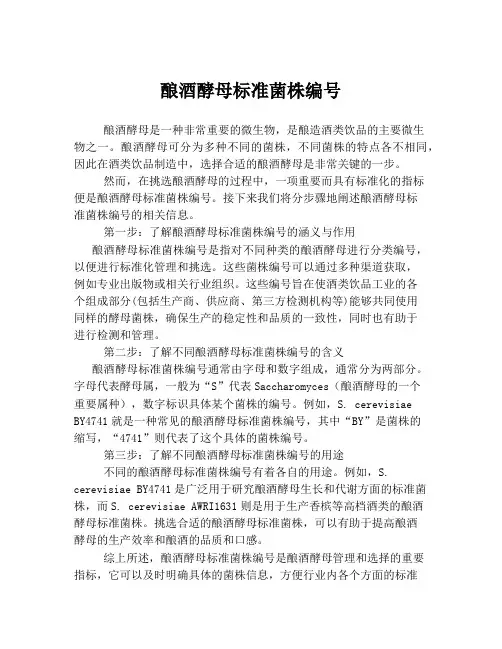
酿酒酵母标准菌株编号酿酒酵母是一种非常重要的微生物,是酿造酒类饮品的主要微生物之一。
酿酒酵母可分为多种不同的菌株,不同菌株的特点各不相同,因此在酒类饮品制造中,选择合适的酿酒酵母是非常关键的一步。
然而,在挑选酿酒酵母的过程中,一项重要而具有标准化的指标便是酿酒酵母标准菌株编号。
接下来我们将分步骤地阐述酿酒酵母标准菌株编号的相关信息。
第一步:了解酿酒酵母标准菌株编号的涵义与作用酿酒酵母标准菌株编号是指对不同种类的酿酒酵母进行分类编号,以便进行标准化管理和挑选。
这些菌株编号可以通过多种渠道获取,例如专业出版物或相关行业组织。
这些编号旨在使酒类饮品工业的各个组成部分(包括生产商、供应商、第三方检测机构等)能够共同使用同样的酵母菌株,确保生产的稳定性和品质的一致性,同时也有助于进行检测和管理。
第二步:了解不同酿酒酵母标准菌株编号的含义酿酒酵母标准菌株编号通常由字母和数字组成,通常分为两部分。
字母代表酵母属,一般为“S”代表Saccharomyces(酿酒酵母的一个重要属种),数字标识具体某个菌株的编号。
例如,S. cerevisiaeBY4741就是一种常见的酿酒酵母标准菌株编号,其中“BY”是菌株的缩写,“4741”则代表了这个具体的菌株编号。
第三步:了解不同酿酒酵母标准菌株编号的用途不同的酿酒酵母标准菌株编号有着各自的用途。
例如,S. cerevisiae BY4741是广泛用于研究酿酒酵母生长和代谢方面的标准菌株,而S. cerevisiae AWRI1631则是用于生产香槟等高档酒类的酿酒酵母标准菌株。
挑选合适的酿酒酵母标准菌株,可以有助于提高酿酒酵母的生产效率和酿酒的品质和口感。
综上所述,酿酒酵母标准菌株编号是酿酒酵母管理和选择的重要指标,它可以及时明确具体的菌株信息,方便行业内各个方面的标准化管理及信息交流。
了解不同酿酒酵母标准菌株编号的含义、作用和用途,可以使我们更加快速准确地选择合适的酿酒酵母,提高酒类饮品生产的效率与品质。
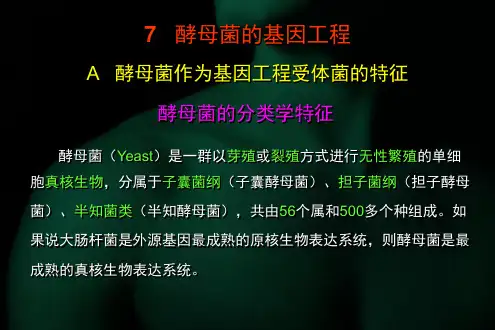
所有质粒载体汇总酿酒酵母表达载体pYES2,pYES2/NT,pYES2/CT,pYES3,pYES6, pYCplac22-GFP,酵母载体pAUR123,pRS303TEF,pRS304, pRS305,pRS306,pY13TEF,pY14TEF,pY15TEF,pY16TEF, 酵母基因重组表达载体pUG6, pSH47,酵母单杂载体pHISi,pLacZi,pHIS2, pGAD424, 酵母双杂交系统:酿酒酵母Y187, 酿酒酵母AH109;质粒pGADT7,pGBKT7;对照质粒pGBKT7-53,pGBKT7-lam,pGADT7-T,PCL1,酿酒酵母菌株INVSc1,YM4271, AH109,Y187,Y190,毕赤酵母表达载体pPIC9K,pPIC9K-His,pPIC3.5K,pPICZalphaA,B,C,pPICZA,B,C,pGAPZαA,pAO815,pPIC9k-His,pHIL-S1,pPink hc,配套毕赤酵母Pichiapink,毕赤酵母宿主X33,KM71,KM71H,GS115,原核表达载体pQE30,31,32,40,60,61,62,等原核表达载体,包括pET系列,pET-GST,pGEX系列(含GST标签),pMAL系列pMAL-c2x,-c4x,-c4e,-c5x,-p5x,pBAD,pBADHis,pBADmycHis系列,pQE系列,pTrc99a,pTrcHis系列,pBV220,221,222,pTXB系列,pLLP-ompA,pIN-III-ompA (分泌型表达系列),pQBI63(原核表达带荧光)pET3a, pET 3d, pET 11a, pET 12a, pET 14b, pET 15b, pET 16b, pET 17b, pET 19b, pET 20b, pET 21a,b,d, pET 22b, pET 23a, pET 23b, pET 24a,b, pET 25b, pET 26b, pET 27b, pET 28a,b, pET 29a, pET 30a, pET 31b, pET 32a, pET 35b, pET 38b, pET 39b, pET 40b, pET 41a,b pET 42a, pET 43.1a,b pET 44a, pET 49b pET302,303 pET His,pET Dsb,pET GST,pET Trx pQE2, pQE9 pQE30,31,32, pQE 40pQE70 pQE80L pQETirs system pRSET-A pRSET-B pRSET-C pGEX4T-1,-2,-3,5x-1,6p-1,6p-2,2tk,3c pBV220,221,222 pTrcHisA,B,C pBAD24,34,43 pBAD HisA,B,C pPinPoint-Xa1,Xa2,Xa3 pMALc2x, p2x pBV220 pGEM Ex1, pGEM7ZF(+), pTrc99A, pTwin1, pEZZ18 pkk232-8,pkk233-3,pACYC184,pBR322,pUC119pTYB1,pTYB2,pTYB4,pTYB11 pBlueScript SK (+),pBlueScript SK (-)pLLP ompA, pINIIIompA, pMBP-P ,pMBP-C, 大肠杆菌冷激质粒: pColdI pColdII pColdIII pColdTF 原核共表达质粒:pACYCduet-1,pETduet-1,pCDFduet-1,pRSFduet-1 Takara公司大肠杆菌分子伴侣: pG-KJE8 pGro7 pKJE7 pGTf2 pTf16 大肠杆菌宿主细胞: DH5a JM101 JM103JM105 JM107 JM109 JM110 Top10 Top10F BL21(DE3)HB101 ER2529 E2566 C2566 MG1655 XL-10gold XL blue M15 JF1125 K802 SG1117 BL21(AI)BL21(DE3)plysS TG1 TB1 DH5a(pir)Tuner(DE3)Bl21 codonplusRIPL Novablue (DE3)Rosetta Rosetta(DE3)Rosetta(DE3)plys Rosetta-gami(DE3)Rosetta-gamiB(DE3), Rosetta-gamiB(DE3)plysS Orgami (DE3)OrgamiB(DE3)HMS174(DE3)植物表达/RNAi载体农杆菌pBI121,pBI121-GFP,pBI101,pBI221,pSN1301,pUN1301,pRTL2 , pRTL2-GFP , pRTL2-CFP, pRTL2-RFP , pRTL2-YFP,pCAMBIA 1300, 1301, 1302,1303,1304,1305, 1381Z,1391Z,2300, 2301,3300,3301,pCAMBIA super1300,pCAMBIAsuper1300-GFP,pPZP212,pPZP2121,pPZP212-GFP,pGDG,RNAi载体pART27,pHANNIBAL,pKANNIBAL, pFGC5941,pTCK303, pTRV1,pTRV2,T-DNA插入载体(随机突变体库)pSKI015,pSKI074,真菌ATMT载体pBIG2RHPH2-GUS-GFP,pBHt1枯草芽孢杆菌表达载体pWB980,pHT43,pHP13,pHP43,pBE2,pMUTIN4,pUB110,pE194,pMA5,pMK3,pMK4,pHT304,pHY300PLK,pBest502,pDG1363,pSG1154,pAX01, pSAS144,pDL,pDG148-stu,pDG641,pAL12,pUCX05-bgaB,pHT01,配套菌株BS 168,WB600,WB800,WB700,WB800N,1012,FZB42,1A747,广宿主质粒pVLT33RNAi基因沉默干扰敲除载体pSilencer1.0,pSilencer 2.1-U6 hygro,pSilencer 3.1-H1 hygro,pSilencer 3.1-H1 neo,pSilencer 4.1-CMV neo, pSilencer 4.1-CMV puro pMIR-REPORT Luciferase RNAi载体(oligoengine)pSuper-puro RNAi逆转录病毒载体(clontech): RNAi-Ready pSIREN-Retro Q, RNAi-Ready pSIREN-RetroQ-ZsGreen(Luciferase shRNA Annealed Oligonucleotide)RNAi慢病毒载体(addgene): pLKO.1 哺乳动物表达载体pcDNA3.1+/-,pcDNA4/HisMax B,pSecTag2 A,pVAX1,pBudCE4.1,pTracer CMV2,pcDNA3.1(-)/myc-His A ,pcDNA6-Myc/His B,pCEP4, pIRES,pIRESneo,pIRES hyg3,pCMV-myc,pCMV-HA,pIRES-puro3,pIRES-neo3,pCAGGS哺乳动物双杂交系统pACT,pBIND,pACT-MyoD,pBIND-Id,pG5luc,pCMV-BD, pCMV-AD, pBD-p53, pFR-luc,Cytotrap Two-Hybrid System:pSos, pSos MAFB, pMyr蜕皮激素诱导系统pIND, pVgRxR,LacSwith II哺乳动物诱导表达系统:pOPRSVI ,pOPI3CAT,pCMVLacI,GeneSwitch System:pSwitch哺乳动物表面展示系统:pDisplay, 四环素调控系统(Invitrogen):pcDNA4/TO/Myc-His A,pcDNA4/TO/Myc-His B,pcDNA4/TO/Myc-His C,pcDNA4/TO/Myc-His/LacZ,pcDNA6/TR四环素调控系统(Clontech):pTet-On,pTet-Off,pTRE2,pRevTRE,pRevTet-On,pRevT et-off信号通路报告载体:pGAS-TA-Luc,pSTAT3-TA-Luc, pISRE-TA-Luc, pTA-Luc,pIκB-EGFP,pNFAT-TA-Luc,pCaspase3-sensor,pAP1(PMA)-Luc;pGL4.26[luc2P/minP/Hygro],pGL4.29[luc2P/CRE/Hygro],pGL 4.30[luc2P/NFA T-RE/Hygro],pGL4.75;p53-Luc,pAP-1-Luc,pNF-κB-Luc,pSRE-Luc,pFA2-Elk1,pFC-MEKK,pFR-luc,Gateway系统(invitrogen)pcDNA6.2-GWEmGFP-miR negative, pLenti 6/TR,pcDNA 6.2-GW EmGFP-miR,乳酸菌表达载体及各种乳酸菌乳酸杆菌菌株,pNZ8148,pLEISS,pMG36e,pBBR1MCS-5,pBBR1MCS-6,pRV610,pLEM415,pHY3 00PLK,分泌型乳酸菌表达载体pVE5523,pPG611.1,pPG612.1等和乳酸杆菌菌株宿主菌NZ9000,MG1363,Lactobacillus casei 1.539,Lactobacillus casei,acidophilus NCFM,1.2,Lactobacillus sakei 23K,L.plantarum,L.rhamnosusGG,B.coagulans,Bifidobacterium bifidum,Bifidobacterium infantis,Lactococcus lactis M17,1663,Lactobacillus reuterii 广宿主表达载体链球菌表达敲除载体假单胞菌表达载体pVLT33,pBBR1MCS-2,3,4,5,6, pJRD215,pJN105,pME6032,Cos 载体pLAFR3,pMP2444(GFP), pHY300PLK,pRT102,pRL1063a, 转座子载体pUT-miniTn5,pMGS100, pWHM10,pKC1139,pSET152,pOJ260,pPG611.1,pPG612.1,腺病毒载体/慢病毒,逆转录病毒表达载体及包装包膜质粒,腺病毒系统(Stratagene): pAdEasy-1,pShuttle-CMV,pShuttle,pAdTrack, pAdTrack-CMV, pShuttle-IRES-hrGFP-1、pShuttle-IRES-hrGFP-2、pShuttle-CMV-lacZ,pShuttle-CMV-EGFP-C,pXC1, pBHGE3, 配套大肠杆菌BJ5183,293,293T cellline 腺相关病毒系统(Stratagene):pAAV-MCS,pAAV-RC,pHelper,pAAV-LacZ,pAAV-IRES-hrGFP,pCMV-MCS,慢病毒载体:pLVX-DsRed-Monomer-N1,pLVX-IRES-ZsGreen1,pLVX-AcGFP1-N1,Lenti6/v 5-EDST-EGFP,pWPXL, FUGW,pLentilox 3.7,RNAi-Ready pSIREN-Retro Q,RNAi-Ready pSIREN-Retro Q-ZsGreen,pSUPER.Retro-GFP/Neo,pSUPER-Retro-Neo, pSUPER.Retro-puro,PLNCX PLNCX2 pMSCV-HYG pMSCV-neo pMSCV-puro pLEGFP-C1 pLOX-CW-CRE pLOX-GFP-IRES-TK pRetroX-IRES-DsRedExpress, pLVX-IRES-mCherry质粒载体。
酵母菌表面展示系统的构建与转化方法酵母菌表面展示系统是一种重要的生物工程技术,用于在酵母菌表面显示外源蛋白质或多肽,以实现其在生物学研究、药物开发和工业应用等领域的广泛应用。
本文将介绍酵母菌表面展示系统的构建和转化方法。
一、酵母菌表面展示系统的构建1. 选择适合的酵母菌在构建酵母菌表面展示系统时,需要选择适合的酵母菌株。
比较常用的酵母菌株包括酿酒酵母(Saccharomyces cerevisiae)和甲醇酵母(Pichia pastoris)等。
这些酵母菌株均具有先天的分泌机制,可以将外源蛋白质或多肽导向到细胞表面。
2. 构建载体构建酵母菌表面展示系统的关键是合适的载体。
常用的载体包括质粒和插入型载体。
质粒载体通常用于酵母本身的转化,插入型载体则涉及将外源蛋白质或多肽导入载体中。
载体设计需要考虑到一些关键因素,如启动子、信号序列和酵母菌表面展示蛋白质的结构等。
3. 构建酵母菌表面展示蛋白质基因库酵母菌表面展示系统通常需要构建蛋白质基因库,以供后续的筛选和鉴定。
可以使用基于PCR扩增或化学合成的方法构建蛋白质基因库。
构建基因库时,可以考虑使用随机连接法、拼接PCR法或重组法等多种方法。
二、酵母菌表面展示系统的转化方法1. 酵母菌的转化方法将构建好的酵母菌表面展示系统载体通过转化方法导入酵母菌中。
转化方法可以分为化学转化和电转化两种。
- 化学转化: 化学转化法是较为简单和常用的方法之一,利用酵母菌细胞壁的通透性,通过渗透作用或高浓度锂离子处理,将外源DNA转化入酵母菌细胞。
- 电转化: 电转化法是将外源DNA转化入酵母菌细胞的另一种常用方法。
通过在电容器中给予高压脉冲,使DNA能在细胞表面形成瞬时的孔洞,以便DNA进入细胞内。
2. 酵母菌表面展示蛋白质的筛选与鉴定成功转化后,需要对酵母菌表面展示蛋白质进行筛选与鉴定。
常用的方法包括荧光激活细胞排序(Flow cytometry-based cell sorting)、酵母双杂交(yeast two-hybrid)等。
酵母型号与特性一、酿造干白葡萄酒的酵母(一)、VL1(1)葡萄品种:用于各种白葡萄品种(2)酿酒特性:酒精发酵过程中生成的乙烯苯酚特别少,尤其遇到光照不足、降雨量多的年份,部分腐烂的葡萄用该菌种是最佳的首选,可限制乙烯苯酚的产生。
(3)风格:该菌种能最大限度地将葡萄含有的天然芳香物质和产地的种植土壤特点在酒中得以还原。
从而使获得的葡萄酒幽雅芬芳,丰满肥硕。
(4)酿酒类型:浓郁高端耐久存干白。
(二)、VL3(1)葡萄品种:霞多丽等。
(2)酿酒特性:该菌种可以显示和优化各种白葡萄酒的芳香潜力。
通过它对葡萄酒中香味母体的作用,其酶促结构使它显示各种特性香味。
(3)风格:具有黄杨和黑醋栗的芽等香味,浓郁丰富,令人喜爱。
(4)酿酒类型:浓郁顶级耐久存干白。
(三)、ST(1)葡萄品种:琼瑶浆等。
(2)酿酒特性:该菌种和SO2的结合潜力低,并且非常灵敏,容易使发酵停止,具有达到15%酒精发酵能力,挥发酸、硫化氢聚集较少。
(3)风格:完美和谐,口感均衡。
(4)酿酒类型:高档甜型葡萄酒。
(四)、BO213(1)葡萄品种:各种白葡萄(2)酿酒特性:适用于低温发酵的甜葡萄酒和白葡萄酒,具有抵抗高酒度的良好特性。
特别是具有再启动停止发酵的巨大潜力。
(3)酿酒类型:停止发酵的再启动。
(五)、CY3079(1)葡萄品种:霞多丽、雷司令、贵人香、白品乐等。
(2)酿酒特性:起酵缓慢、发酵平稳,挥发酸、硫化氢聚集较少,泡沫低、沉淀好,发酵结束后具有陈酿的酒泥香。
(3)风格:新鲜的黄油味、烤面包、蜂蜜、坚果、香子兰和杏仁等香味,陈酿的酒泥香伴有烤面包、榛子和木质对等香气特点。
(4)酿酒类型:浓郁顶级耐久存干白。
(六)、R-HST(1)葡萄品种:雷司令、贵人香。
(2)酿酒特性:发酵力强,在较低温度下迅速启动,既能保留葡萄品种固有的新鲜果香,又能提高结构感,也适合陈酿。
(3)风格:能展露出雷司令、贵人香等品种的典型性香气,果香浓郁、醇和爽口、酒体完整、回味延绵,陈酿后表现亦佳。
酿酒酵母4742生长条件
酿酒酵母4742是一种常用的酿酒酵母菌株,它在酿酒过程中起着重要作用。
为了保证酵母菌的正常生长和发酵效果,我们需要关注以下几个方面的生长条件:
1. 温度,酿酒酵母4742的适宜生长温度一般在20°C至
30°C之间。
在这个温度范围内,酵母菌的生长速度和发酵效果都能得到较好的保证。
过低或过高的温度都会影响酵母的生长和发酵效果。
2. pH值,酵母菌的生长和发酵受到环境pH值的影响。
一般来说,酿酒酵母4742的适宜生长pH范围在4.0至6.0之间。
在这个范围内,酵母菌能够较好地进行生长和发酵。
3. 氧气,酵母菌是一种厌氧生物,但在生长初期和繁殖阶段需要一定量的氧气。
因此,在酿酒过程中需要注意提供适量的氧气,以促进酵母的生长和繁殖。
4. 营养物质,酵母菌生长需要吸收碳源、氮源、矿物质等营养物质,这些物质对于酵母菌的生长和发酵都是至关重要的。
在酿酒
过程中,需要提供适量的营养物质,以满足酵母菌的生长需求。
总的来说,酿酒酵母4742的生长条件包括适宜的温度、pH值、氧气和营养物质。
合理控制这些生长条件可以促进酵母菌的生长和
发酵效果,从而保证酿酒的质量和口感。
希望这些信息能够满足你
的需求,如果还有其他问题,欢迎继续提问。
Commonly used strains▪▪van Dijken et al. (2000) Enzyme Microb Technol 26:706-714 - compares various characteristics of commonly used lab strains▪Winzeler et al. (2003) Genetics 163:79-89 - uses SFP (single-feature polymorphisms) analysis to study genetic identity between common lab strainsS288CGenotype:MATαSUC2 gal2 mal mel flo1 flo8-1 hap1 ho bio1 bio6Notes: Strain used in the systematic sequencing project, the sequence stored in SGD. S288C does not form pseudohyphae. In addition, since it has a mutated copy of HAP1, it is not a good strain for mitochondrial studies. It has an allelic variant of MIP1 which increases petite frequency. S288C strains are gal2- and they do not use galactose anaerobically.The S288C genome was recently resequenced at the Sanger Institute.References:Mortimer and Johnston (1986) Genetics 113:35-43.BY4743Genotype:MAT a/αhis3Δ1/his3Δ1 leu2Δ0/leu2Δ0 LYS2/lys2Δ0 met15Δ0/MET15 ura3Δ0/ura3Δ0Notes: Strain used in the systematic deletion project, generated from a cross between BY4741 and BY4742, which are derived from S288C. As S288c, these strains have an allelic variant of MIP1 which increases petite frequency. See Brachmann et al. reference for details.References:Brachmann et al. (1998) Yeast 14:115-32.FY4Genotype:MAT aNotes: Derived from S288C.References:Winston et al. (1995) Yeast 11:53-55.FY1679Genotype:MAT a/αura3-52/ura3-52 trp1Δ63/TRP1 leu2Δ1/LEU2 his3Δ200/HIS3 GAL2/GALNotes: Isogenic to S288C; used in the systematic sequencing project, the sequence stored in SGD.References:Winston et al. (1995) Yeast 11:53-55.AB972Genotype:MATα X2180-1B trp10 [rho 0]Notes: Isogenic to S288C; used in the systematic sequencing project, the sequence stored in SGD. AB972 is an ethidium bromide-induced rho- derivative of the strain X2180-1B-trp1.References:Olson MV et al. (1986) Proc. Natl. Acad. Sci. USA 83:7826-7830.A364AGenotype:MAT a ade1 ade2 ura1 his7 lys2 tyr1 gal1 SUC mal cup BIONotes: Used in the systematic sequencing project, the sequence stored in SGD.References:Hartwell (1967) J. Bacteriol. 93:1662-1670.XJ24-24aGenotype:MAT a ho HMa HMα ade6 arg4-17 trp1-1 tyr7-1 MAL2Notes: Derived from, but not isogenic to, S288CReferences:Strathern et al. (1979) Cell 18:309-319DC5Genotype:MAT a leu2-3,112 his3-11,15 can1-11Notes: Isogenic to S288C; used in the systematic sequencing project, the sequence stored in SGD.References:Broach et al. (1979) Gene 8:121-133X2180-1AGenotype:MAT a SUC2 mal mel gal2 CUP1Notes:S288c spontaneously diploidized to give rise to X2180. The haploid segregants X2180-1a and X2180-1b were obtained from sporulated X2180YNN216Genotype:MAT a/αura3-52/ura3-52 lys2-801amber/lys2-801amber ade2-101ochre/ade2-101ochreNotes: Congenic to S288C (see Sikorski and Hieter). Used to derive YSS and CY strains (see Sobel and Wolin).YPH499Genotype:MAT a ura3-52 lys2-801_amber ade2-101_ochre trp1-Δ63 his3-Δ200 leu2-Δ1Notes: Contains nonrevertible (deletion) auxotrophic mutations that can be used for selection of vectors. Notethat trp1-Δ63, unlike trp1-Δ1, does not delete adjacent GAL3 UAS sequence and retains homology to TRP1 selectable marker.gal2-, does not use galactose anaerobically. Derived from the diploid strain YNN216 (Johnston and Davis 1984; original source: M. Carlson, Columbia University), which is congenic with S288C.YPH500Genotype:MATαura3-52 lys2-801_amber ade2-101_ochre trp1-Δ63 his3-Δ200 leu2-Δ1Notes:MATα strain isogenic to YPH499 except at mating type locus. Derived from the diploid strain YNN216 (Johnston and Davis 1984; original source: M. Carlson, Columbia University), which is congenic with S288C.YPH501Genotype:MAT a/MATαura3-52/ura3-52 lys2-801_amber/lys2-801_amber ade2-101_ochre/ade2-101_ochretrp1-Δ63/trp1-Δ63 his3-Δ200/his3-Δ200 leu2-Δ1/leu2-Δ1Notes:a/α diploid isogenic to YPH499 and YPH500. Derived from the diploid strain YNN216 (Johnston and Davis 1984; original source: M. Carlson, Columbia University), which is congenic with S288C.Sigma 1278BNotes: Used in pseudohyphal growth studies. Detailed notes about the sigma strains have been kindly provided by Cora Styles.Granek and Magwene, PLoS Genet. 2010 Jan 22;6(1):e1000823, established that certain lineages of theSigma1278B background contain a nonsense mutation in RIM15, a G-to-T transversion at position 1216 that converts a Gly codon to an opal stop codon. This rim15 mutation interacts epistatically with mutations in certain other genes to affect colony morphology.Annotation of the Sigma1278b genome and information about the systematic deletion collection can be found here. SK1Genotype:MAT a/α HO gal2 cup S can1R BIONotes: Commonly used for studying sporulation or meiosis. Canavanine-resistant derivative.The SK1 genome was sequenced at the Sanger Institute.References:Kane SM and Roth J. (1974) Bacteriol. 118: 8-14CEN.PK (aka CEN.PK2)Genotype:MAT a/α ura3-52/ura3-52 trp1-289/trp1-289 leu2-3_112/leu2-3_112 his3 Δ1/his3 Δ1 MAL2-8C/MAL2-8C SUC2/SUC2Notes: CEN.PK possesses a mutation in CYR1 (A5627T corresponding to a K1876M substitution near the end of the catalytic domain in adenylate cyclase which eliminates glucose- and acidification-induced cAMP signalling and delays glucose-induced loss of stress resistance (Vanhalewyn et al., 1999; Dumortier et al., 2000).References:van Dijken et al. (2000) Enzyme Microb Technol 26:706-714W303Genotype:MAT a/MATα {leu2-3,112 trp1-1 can1-100 ura3-1 ade2-1 his3-11,15} [phi+]Notes: W303 also contains a bud4 mutation that causes haploids to bud with a mixture of axial and bipolar budding patterns. In addition, the original W303 strain contains the rad5-535 allele. As S288c, W303 has an allelic variantof MIP1 which increases petite frequency.The W303 genome was sequenced at the Sanger Institute.References: W303 constructed by Rodney Rothstein (see detailed notes from RR and Stephan Bartsch).bud4 info: Voth et al. (2005) Eukaryotic Cell, 4:1018-28.rad5-535 info: Fan et al. (1996) Genetics 142:749W303-1AGenotype:MAT a {leu2-3,112 trp1-1 can1-100 ura3-1 ade2-1 his3-11,15}Notes: W303-1A possesses a ybp1-1 mutation (I7L, F328V, K343E, N571D) which abolishes Ybp1p function, increasing sensitivity to oxidative stress.References: W303 constructed by Rodney Rothstein (see detailed notes from RR and Stephan Bartsch).ybp1-1 info: Veal et al. (2003) J. Biol. Chem. 278:30896-904.W303-1BGenotype:MATα {leu2-3,112 trp1-1 can1-100 ura3-1 ade2-1 his3-11,15}References: W303 constructed by Rodney Rothstein (see detailed notes from RR and Stephan Bartsch).W303-K6001Genotype:MAT a; {ade2-1, trp1-1, can1-100, leu2-3,112, his3-11,15, GAL, psi+, ho::HO::CDC6 (at HO), cdc6::hisG, ura3::URA3 GAL-ubiR-CDC6 (at URA3)}References: K6001 was developed by Bobola et al in Kim Nasmyth's lab (PMID: 8625408), and has become a common model in yeast aging research (PMID: 15489200). Its genome has been sequenced by Timmermann et al (PMID: 20729566)D273-10BGenotype:MATαmalNotes: Normal cytochrome content and respiration; low frequency of rho-. This strain and its auxotrophic derivatives were used in numerious laboratories for mitochondrial and related studies and for mutant screens. Good respirer that's relatively resistant to glucose repression.References:Sherman, F. (1963) Genetics 48:375-385.FL100Genotype:MAT aReferences:Lacroute, F. (1968) J. Bacteriol. 95:824-832.Sources: ATCC: 28383SEY6210/SEY6211Genotype:MAT a/MATαleu2-3,112/leu2-3,112 ura3-52/ura3-52 his3-Δ200/his3-Δ200 trp1-Δ901/trp1-Δ901ade2/ADE2 suc2-Δ9/suc2-Δ9 GAL/GAL LYS2/lys2-801Notes: SEY6210/SEY6211, also known as SEY6210.5, was constructed by Scott Emr and has been used in studies of autophagy, protein sorting etc. It is the product of crossing with strains from 5 different labs (Gerry Fink, Ron Davis, David Botstein, Fred Sherman, Randy Schekman). It has several selectable markers, good growth properties and good sporulation.References:Robinson et al. (1988) Mol Cell Biol 8(11):4936-48SEY6210Genotype:MATαleu2-3,112 ura3-52 his3-Δ200 trp1-Δ901 suc2-Δ9 lys2-801; GALNotes: SEY6210 is a MATalpha haploid constructed by Scott Emr and has been used in studies of autophagy, protein sorting etc. It is the product of crossing with strains from 5 different labs (Gerry Fink, Ron Davis, David Botstein, Fred Sherman, Randy Schekman). It has several selectable markers and good growth properties.References:Robinson et al. (1988) Mol Cell Biol 8(11):4936-48SEY6211Genotype:MAT a leu2-3,112 ura3-52 his3-Δ200 trp1-Δ901 ade2-101 suc2-Δ9; GALNotes: SEY6211 is a MATa haploid constructed by Scott Emr and has been used in studies of autophagy, protein sorting etc. It is the product of crossing with strains from 5 different labs (Gerry Fink, Ron Davis, David Botstein, Fred Sherman, Randy Schekman). It has several selectable markers and good growth properties.References:Robinson et al. (1988) Mol Cell Biol 8(11):4936-48JK9-3dThere are a, alpha and a/alpha diploids of JK9-3d with the following genotypes:Genotypes: JK9-3da MAT a leu2-3,112 ura3-52 rme1 trp1 his4JK9-3dα has the same genotype as JK9-3da with the exception of the MAT locusJK9-3da/α is homozygous for all markers except mating typeNotes: JK9-3d was constructed by Jeanette Kunz while in Mike Hall's lab. She made the original strain while Joe Heitman isolated isogenic strains of opposite mating type and derived the a/alpha isogenic diploid by mating type switching. It has in its background S288c, a strain from the Oshima lab, and a strain from the Herskowitz lab. It was chosen because of its robust growth and sporulation, as well as good growth on galactose (GAL+) (so that genes under control of the galactose promoter could be induced). It may also have a SUP mutation that allows translation through premature STOP codons and therefore produces functional alleles with many point mutations. References:Heitman et al. (1991a) Science 253(5022):905-9 and Heitman et al. (1991b) Proc Natl Acad Sci U S A 88(5):1948-52RM11-1aGenotype:MAT a leu2Δ ura3Δ ho::KanNotes: RM11-1a is a haploid derivative of Bb32(3), a natural isolate collected by Robert Mortimer from a California vineyard, as in Mortimer et al., 1994. It has high spore viability (80–90%) and has been extensively characterized phenotypically under a wide range of conditions. It has a significantly longer life span than typical lab yeast strains and accumulates age-associated abnormalities at a lower rate. It displays approximately 0.5–1% sequence divergence relative to S288c. More information is available at the Broad Institute website.References:Brem et al. (2002) Science 296(5568):752-5Y55Genotype:MAT a /MAT alpha HO/HO。